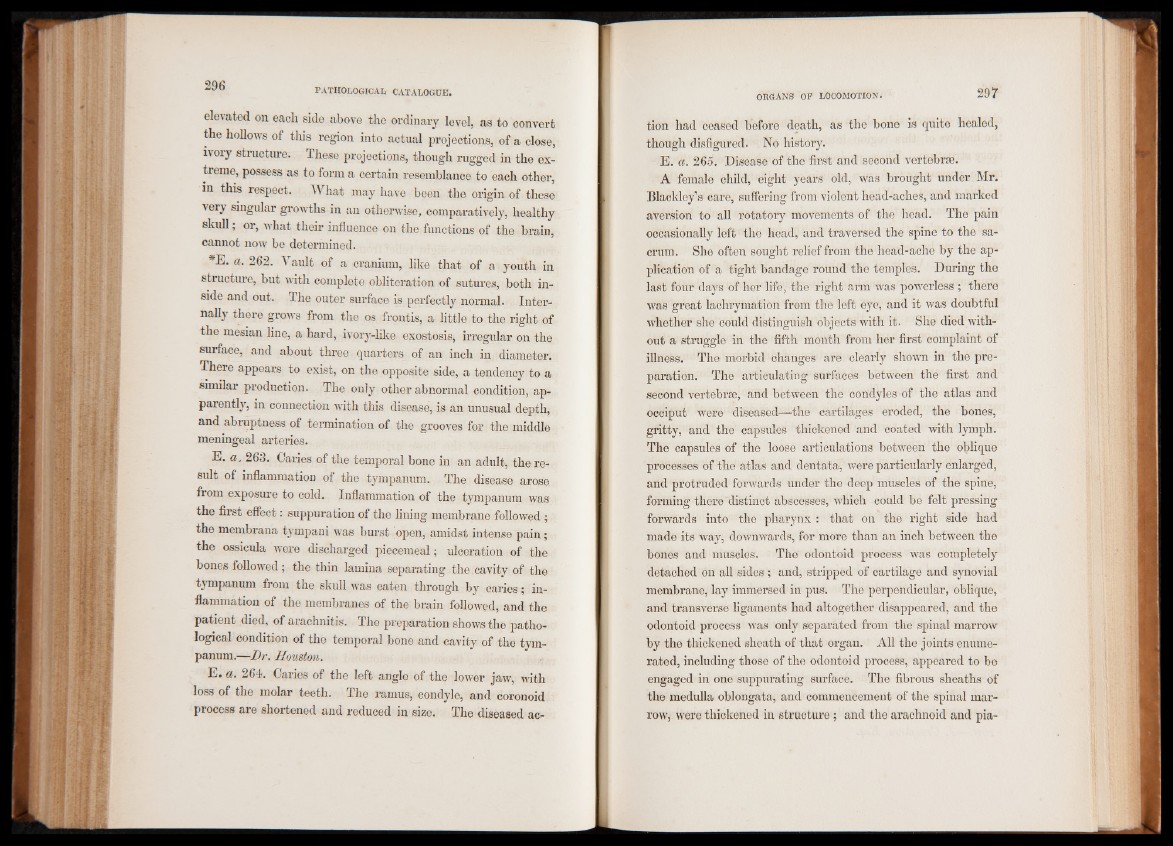
elevated on each side above the ordinary level, as to convert
the hollows of this region into actual projections, of a close,
ivory structure. These projections, though rugged in the extreme,
possess as to form a certain resemblance to each other,
m this respect. What may have been the origin of these
very singular growths in an otherwise, comparatively, healthy
skull; or, what their influence on the functions of the brain,
cannot now be determined.
*E. a. 262. Vault of a cranium, like that of a youth in
structure, but with complete obliteration of sutures, both inside
and out. The outer surface is perfectly normal. Internally
there grows from the os frontis, a little to the right of
the mesian line, a hard, ivorv-like exostosis, irregular on the
surface, and about three quarters of an inch in diameter.
There appears to exist, on the opposite side, a tendency to a
similar production. The only other abnormal condition, apparently,
in connection with this disease, is an unusual depth,
and abruptness of termination of the grooves for the middle
meningeal arteries.
E. a, 263. Caries of the temporal bone in an adult, the result
of inflammation of the tympanum. The disease arose
from exposure to cold. Inflammation of the tympanum was
the first effect: suppuration of the lining membrane followed ;
the membrana tympani was burst open, amidst intense pain;
the ossicula were discharged piecemeal; ulceration of the
bones followed; the thin lamina separating the . cavity of the
tympanum from the skull was eaten through by caries; inflammation
of the membranes of the brain followed, and the
patient died, of arachnitis. The preparation shows the pathological
condition of the temporal bone and cavity of the tympanum.—
Dr. Houston.
E. a. 264. Caries of the left angle of the lower jaw, with
loss of the molar teeth. The ramus, condyle, and coronoid
process are shortened and reduced in size. The diseased action
had ceased before death, as the bone is quite healed,
though disfigured. No history.
E. a. 265. Disease of the first and second vertebrae.
A female child, eight years old, was brought under Mr.
Blackley’s care, suffering from violent head-aches, and marked
aversion to all rotatory movements of the head. The pain
occasionally left the head, and traversed the spine to the sacrum.
She often sought relief from the head-ache by the application
of a tight bandage round the temples. During the
last four days of her life, the right arm was powerless ; there
was great lachrymation from the left eye, and it was doubtful
whether she could distinguish objects with it. She died without
a struggle in the fifth month from her first complaint of
illness. The morbid changes are clearly shown in the preparation.
The articulating surfaces between the first and
second vertebrae, and between the condyles of the atlas and
occiput were diseased—the cartilages eroded, the bones,
gritty, and the capsules thickened and coated with lymph.
The capsules of the loose articulations between the oblique
processes of the atlas and dentata, were particularly enlarged,
and protruded forwards under the deep muscles of the spine,
forming there distinct abscesses, which could be felt pressing
forwards into the pharynx : that on the right side had
made its way, downwards, for more than an inch between the
bones and muscles. The' odontoid process was completely
detached on all sides ; and, stripped of cartilage and synovial
membrane, lay immersed in pus. The perpendicular, oblique,
and transverse ligaments had altogether disappeared, and the
odontoid process was only separated from the spinal marrow
by the thickened sheath of that organ. All the joints enumerated,
including those of the odontoid process, appeared to be
engaged in one suppurating surface. The fibrous sheaths of
the medulla oblongata, and commencement of the spinal marrow,
were thickened in structure ; and the arachnoid and pia